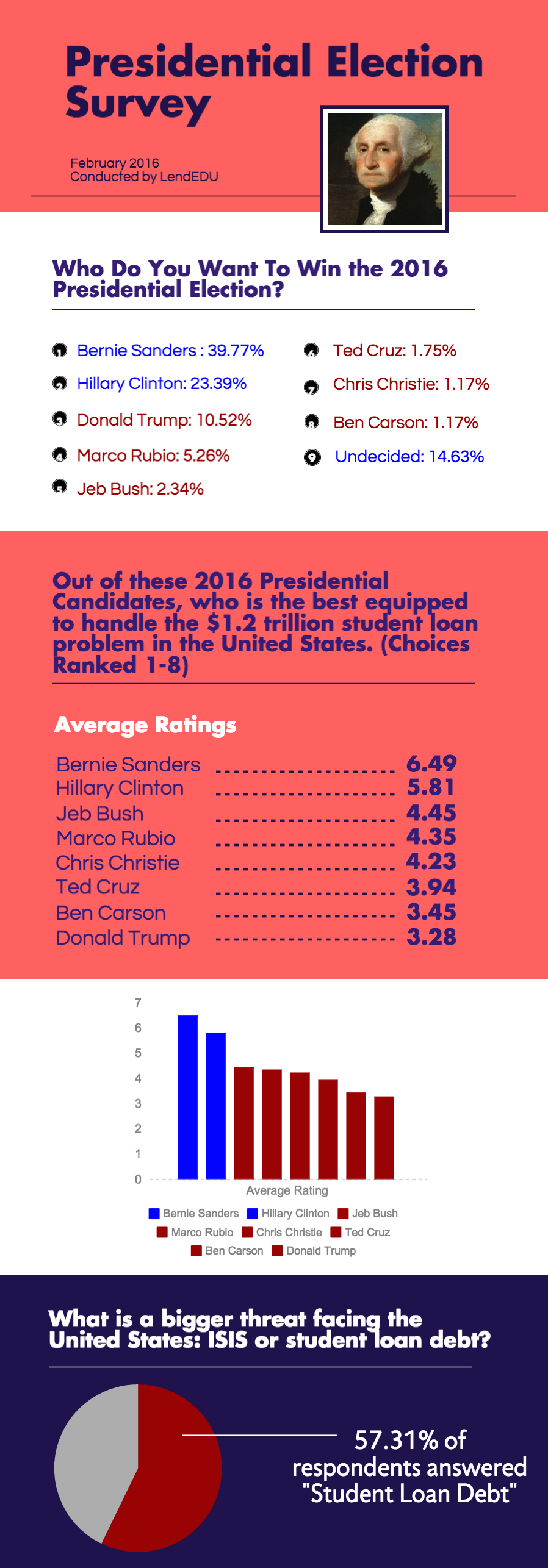The 2016 Presidential race is starting to pick up. In the coming weeks Nevada and South Carolina will host their highly anticipated primaries. After that, the majority of Americans will be making the trip to the ballot box in March and April.
At LendEDU, we work to help the more than 43 million Americans better manage their student loan debt. Today, 7 out of 10 graduates are leaving campus with some form of student debt. The Class of 2016 is expected to have more student loan debt than any class in history!
Candidates on both sides of the aisle have already started talking about student loan policies. Hillary Clinton, Jeb Bush, Bernie Sanders, Marco Rubio, and others have been vocal about their plans to help Millennials escape from crushing student debt. These candidates have announced plans for income-based lines of credit, federal student loan refinancing, and free public college. But which of these candidates and plans are resonating with student loan borrowers?
As part of our February survey (part 1), we decided to find out. At the start of the month we commissioned an online survey of 513 graduated student loan borrowers. At the end of our February survey we asked student loan borrowers three politically charged questions.
Presidential Election Survey Questions and Results
Here are the highlights:
Q. Who do you want to win the 2016 Presidential election?
A. See below:
| Rank | Candidate | Percentage of Vote | Political Party |
| 1 | Bernie Sanders | 39.77% | Democrat |
| 2 | Hillary Clinton | 23.39% | Democrat |
| 3 | Donald Trump | 10.52% | Republican |
| 4 | Marco Rubio | 5.26% | Republican |
| 5 | Jeb Bush | 2.34% | Republican |
| 6 | Ted Cruz | 1.75% | Republican |
| 7 | Chris Christie | 1.17% | Republican |
| 8 | Ben Carson | 1.17% | Republican |
| N/A | Undecided | 14.63% | N/A |
Q. Out of these 2016 Presidential candidates, who is the best equipped to handle the $1.2 trillion student loan problem in the United States? Please rank your choices from 1-8. 8 being the best equipped, 1 being the least equipped.
A. See below:
| Candidate | Average Rating | Political Party |
| Bernie Sanders | 6.49 | Democrat |
| Hillary Clinton | 5.81 | Democrat |
| Jeb Bush | 4.45 | Republican |
| Marco Rubio | 4.35 | Republican |
| Chris Christie | 4.23 | Republican |
| Ted Cruz | 3.94 | Republican |
| Ben Carson | 3.45 | Republican |
| Donald Trump | 3.28 | Republican |
Q. What is a bigger threat facing the United States: ISIS or student loan debt?
A. 57.31% of respondents answered “Student Loan Debt” and 42.69% of respondents answered “ISIS”.
Analysis and Infographic:
It isn’t a huge surprise that the Democratic party candidates are #1 and #2.
Bernie Sanders has certainly tapped into the Millennial demographic. And, both Democratic candidates have been vocal when it comes to the student debt issue.
Donald Trump finished third when respondents were asked who they wanted to win the 2016 Presidential election.
Yet, Donald Trump finished last overall when respondents were asked who was best equipped to handle the $1.2 trillion student loan problem. Donald Trump supporters were outweighed by very negative ratings from respondents who preferred other candidates.
Interestingly, 14.63% of respondents reported that they were undecided. This presents an opportunity for some candidates looking for a boost.
Jeb Bush and Marco Rubio both did fairly well when respondents were asked who was best equipped to handle the $1.2 trillion student loan problem. Both candidates have spent significant time talking about student loan debt.
Our last question wasn’t related to the 2016 Presidential election. That being said, it is clear that candidates should be using student loan debt as a tool in this election cycle.
The majority of our respondents thought that student debt was a bigger threat than ISIS. 43 million Americans isn’t chump change. In the coming months we predict that more candidates will spend money and time on student debt.

For reference, our average respondent held $31,762 in debt at the time of the survey. This number was self reported by the respondent. In addition, 61 percent of respondents were female and 39 percent of the respondents were male. Respondent ages ranged from 22 to 61 years old. All of the respondents graduated from a 4-year college.
See more of LendEDU’s Research
About our contributors
-
 Written by Dave Rathmanner
Written by Dave RathmannerDave Rathmanner has researched and developed content on a variety of finance topics, such as student loans, personal loans, credit cards, and small business loans.